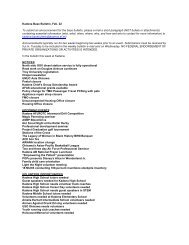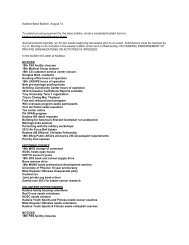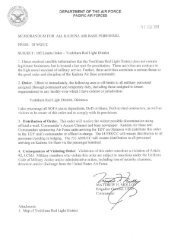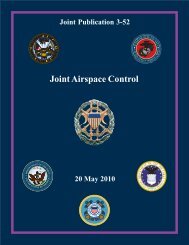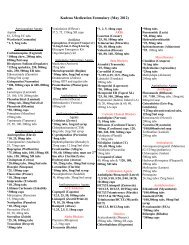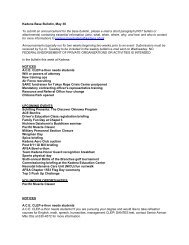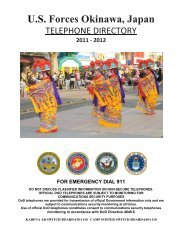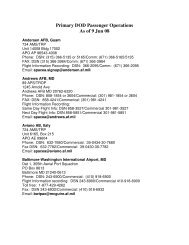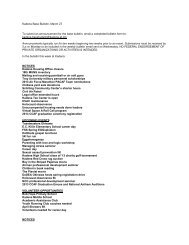JOTRC Handbook - Kadena Air Base
JOTRC Handbook - Kadena Air Base
JOTRC Handbook - Kadena Air Base
Create successful ePaper yourself
Turn your PDF publications into a flip-book with our unique Google optimized e-Paper software.
While the majority of these areas exist within Special Use <strong>Air</strong>space (Warning Areas,<br />
Restricted Areas, etc.), it is important to recognize that non-military surface and air<br />
platforms cannot be restricted nor prohibited from operating in or transiting most areas.<br />
Since offshore OPAREAs are located in international waters, normal “Freedom of <strong>Air</strong>/Sea”<br />
principles apply to airborne and surface vessels.<br />
Hazardous Operations affecting airspace shall be conducted within designated SUA or<br />
ALTRV if the planned operation must occur outside aforementioned SUA.<br />
All operations within these areas shall be conducted cautiously and military units shall<br />
maintain vigilant visual/sensor sanitization to ensure safety. Military units shall apply ORM<br />
principles throughout all evolutions conducted in these areas.<br />
ESTABLISHMENT: In accordance with Joint Committee agreements JC-Incl 76 Memo<br />
937, JC-Incl 77 Memo 938, JC-Incl 79 Memo 940, JC-Incl 86, Memo 948, and JC-Incl 89<br />
Memo 951. These areas include the offshore areas contiguous Okinawa, Japan.<br />
JOSC/<strong>JOTRC</strong> OPERATING AREAS. The areas addressed by this handbook are located<br />
in the country of Japan and their contiguous offshore areas.<br />
GUIDANCE. This handbook prescribes general operating instructions and flight and<br />
procedures applicable to the operation of all aircraft, ships, and submarines operating<br />
within designated operating areas.<br />
This handbook is not intended to cover every contingency that may arise nor every rule of<br />
safety and good practice. In the tactical environment, military exigency may require on-site<br />
deviations from handbooks/procedures contained here. The existing risk of deviation must<br />
continually be weighed against the benefit of deviating from this handbook. Deviation from<br />
specific flight and operating instructions is authorized in emergency situations when, in the<br />
judgment of the pilot in command or Commanding Officer, safety justifies such a deviation.<br />
Standard definitions and word use has been adhered to for such phrases as “Warnings”,<br />
“Cautions”, “Notes”, “Shall”, “Should”, “May”, “Will”, etc. It is often not feasible to<br />
completely specify all situations or circumstances under which provisions of this handbook<br />
shall apply; therefore, wording such as “normally,” “etc.,” “usually,” and “such as” is<br />
employed. Words or clauses of that type shall not be used as loopholes nor shall they be<br />
expanded to include a maneuver, situation, or circumstances that should not be performed<br />
nor encountered.<br />
CHANGE RECOMMENDATIONS. Recommended changes to this handbook may be<br />
submitted by anyone. Submit recommended changes to the JOSC via contact information<br />
listed above.<br />
DISTRIBUTION. Automatic distribution of this handbook and revisions is primarily by<br />
electronic means.



